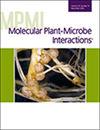求助PDF
{"title":"抑制转酮醇酶突变只会部分恢复共生关系。","authors":"Sabhjeet Kaur, Justin P Hawkins, Ivan J Oresnik","doi":"10.1094/MPMI-02-25-0017-R","DOIUrl":null,"url":null,"abstract":"<p><p>The interaction between <i>Sinorhizobium meliloti</i> and alfalfa is a well-studied model system for symbiotic establishment between rhizobia and legume plants. Proper utilization of carbon sources has been linked with effective symbiotic establishment in <i>S. meliloti</i> strain Rm1021. Previous work has shown that mutation of the gene <i>tktA</i>, which encodes a transketolase involved in the pentose phosphate pathway, resulted in a strain impaired in many biological functions, including the ability to establish symbiosis with alfalfa. Work with this strain revealed the appearance of suppressor mutations that could partially revert the symbiotic phenotype associated with a <i>tktA</i> mutation. Characterization of these suppressor strains showed that carbon phenotypes associated with a mutation in <i>tktA</i> were no longer present and that the production of succinoglycan was partially restored. Central carbon metabolite pools were observed to be different compared with the wild-type and <i>tktA</i> mutant strains. Multiple independent mutations were identified in the gene <i>SMc02340</i>, a Gnt-type negative regulator, upon sequencing. RT-PCR suggested that <i>SMc02340</i> acts as a negative regulator on an operon containing the gene <i>tktB</i>, which becomes upregulated when the suppressor mutation is present or <i>SMc02340</i> is removed. Microscopic analysis revealed a unique symbiotic phenotype. The <i>tktA</i> mutant strain induced root hair curling but could not colonize the apoplastic space. Collectively, the data suggest that the upregulation of <i>tktB</i> can partially bypass some blocks associated with a lesion in <i>tktA</i>, including the colonization of the curled root hair, but cannot fully compensate for the loss of <i>tktA</i>. [Formula: see text] Copyright © 2025 The Author(s). This is an open access article distributed under the CC BY-NC-ND 4.0 International license.</p>","PeriodicalId":19009,"journal":{"name":"Molecular Plant-microbe Interactions","volume":" ","pages":"505-517"},"PeriodicalIF":3.4000,"publicationDate":"2025-07-01","publicationTypes":"Journal Article","fieldsOfStudy":null,"isOpenAccess":false,"openAccessPdf":"","citationCount":"0","resultStr":"{\"title\":\"Suppression of a Transketolase Mutation Leads to Only Partial Restoration of Symbiosis in <i>Sinorhizobium meliloti</i>.\",\"authors\":\"Sabhjeet Kaur, Justin P Hawkins, Ivan J Oresnik\",\"doi\":\"10.1094/MPMI-02-25-0017-R\",\"DOIUrl\":null,\"url\":null,\"abstract\":\"<p><p>The interaction between <i>Sinorhizobium meliloti</i> and alfalfa is a well-studied model system for symbiotic establishment between rhizobia and legume plants. Proper utilization of carbon sources has been linked with effective symbiotic establishment in <i>S. meliloti</i> strain Rm1021. Previous work has shown that mutation of the gene <i>tktA</i>, which encodes a transketolase involved in the pentose phosphate pathway, resulted in a strain impaired in many biological functions, including the ability to establish symbiosis with alfalfa. Work with this strain revealed the appearance of suppressor mutations that could partially revert the symbiotic phenotype associated with a <i>tktA</i> mutation. Characterization of these suppressor strains showed that carbon phenotypes associated with a mutation in <i>tktA</i> were no longer present and that the production of succinoglycan was partially restored. Central carbon metabolite pools were observed to be different compared with the wild-type and <i>tktA</i> mutant strains. Multiple independent mutations were identified in the gene <i>SMc02340</i>, a Gnt-type negative regulator, upon sequencing. RT-PCR suggested that <i>SMc02340</i> acts as a negative regulator on an operon containing the gene <i>tktB</i>, which becomes upregulated when the suppressor mutation is present or <i>SMc02340</i> is removed. Microscopic analysis revealed a unique symbiotic phenotype. The <i>tktA</i> mutant strain induced root hair curling but could not colonize the apoplastic space. Collectively, the data suggest that the upregulation of <i>tktB</i> can partially bypass some blocks associated with a lesion in <i>tktA</i>, including the colonization of the curled root hair, but cannot fully compensate for the loss of <i>tktA</i>. [Formula: see text] Copyright © 2025 The Author(s). This is an open access article distributed under the CC BY-NC-ND 4.0 International license.</p>\",\"PeriodicalId\":19009,\"journal\":{\"name\":\"Molecular Plant-microbe Interactions\",\"volume\":\" \",\"pages\":\"505-517\"},\"PeriodicalIF\":3.4000,\"publicationDate\":\"2025-07-01\",\"publicationTypes\":\"Journal Article\",\"fieldsOfStudy\":null,\"isOpenAccess\":false,\"openAccessPdf\":\"\",\"citationCount\":\"0\",\"resultStr\":null,\"platform\":\"Semanticscholar\",\"paperid\":null,\"PeriodicalName\":\"Molecular Plant-microbe Interactions\",\"FirstCategoryId\":\"99\",\"ListUrlMain\":\"https://doi.org/10.1094/MPMI-02-25-0017-R\",\"RegionNum\":3,\"RegionCategory\":\"生物学\",\"ArticlePicture\":[],\"TitleCN\":null,\"AbstractTextCN\":null,\"PMCID\":null,\"EPubDate\":\"2025/7/25 0:00:00\",\"PubModel\":\"Epub\",\"JCR\":\"Q2\",\"JCRName\":\"BIOCHEMISTRY & MOLECULAR BIOLOGY\",\"Score\":null,\"Total\":0}","platform":"Semanticscholar","paperid":null,"PeriodicalName":"Molecular Plant-microbe Interactions","FirstCategoryId":"99","ListUrlMain":"https://doi.org/10.1094/MPMI-02-25-0017-R","RegionNum":3,"RegionCategory":"生物学","ArticlePicture":[],"TitleCN":null,"AbstractTextCN":null,"PMCID":null,"EPubDate":"2025/7/25 0:00:00","PubModel":"Epub","JCR":"Q2","JCRName":"BIOCHEMISTRY & MOLECULAR BIOLOGY","Score":null,"Total":0}
引用次数: 0
引用
批量引用

 求助内容:
求助内容: 应助结果提醒方式:
应助结果提醒方式:


